Two of my favorite things to do in my practice are to assess movement patterns and use kettlebells. So when I heard about the amalgamation of FMS and StrongFirst I was pretty stoked. Throw on top that Gray Cook and Brett Jones were teaching the course, and it was my most anticipated course of all time.
Gray & Brett
Gray Cook has been the biggest outside influence on my career. After graduating from PT school and practicing impairment based PT, I started to notice that there was something missing. Gray Cook and the SFMA/FMS filled the void. I’ve watched almost all the DVDs, read the books, and have attended the SFMA courses. I was excited to finally catch him live in action. And he didn’t disappoint. The man is extremely entertaining, engages you with every word, somehow talks in quotes, and delivers complex and deep concepts in a country simple manner. And if you can catch him during the breaks he’d blow your mind. Plus, it’s great to see his passion for movement. He’s not trying to make money, put down other approaches, or spread a dogma; he’s just trying to help humans “move well, move often”.
The surprise for me was Brett Jones. I’ve heard him in a couple podcast interviews and youtube videos, but I didn’t know what to expect in a course. I was pretty blown away with his expertise and perspective. He is an extremely knowledgeable, humble, and humorous speaker. But my favorite part about Jones was the practicality of his knowledge. Many times I feel like instructors live in the fantasy black and white world where all their patients do everything they say and get 100% better. The information and clinical pearls from Jones were extremely applicable and realistic. Listening to and talking to Jones was like talking to the smartest co-worker you’ve ever had.
Together, Brett Jones and Gray Cook were outstanding. After both of them speak on a topic, there aren’t many questions left to answer.
The Course
The course had 1 lecture to start on the FMS and a Gray Cook bonus lecture at the end. The rest of the 3 days were packed with clinical pearls on screening, interpretation, corrective strategies, technique, programming, and kettlebells. The amount I learned that can immediately go into practice is overwhelming. I cannot recommend this course enough for anyone that is interested in movement.
There’s no way to possibly go over all these clinical pearls in a blog post, but I’ll try to highlight some of the great stuff I learned.
46 Things I Learned at Foundational Strength
1) “The best way to get motor control is through compression or distraction” – Gray Cook
2) “Motor Control is Alignment, with Integrity, Under Load” – Gray Cook
3) Quotes 1 & 2 explain the rationale behind most of the exercises we learned in this course
4) I need to redo all of my FMS screens; I was way too lax.
One of the assistants said it best – “A 3 should look oddly graceful”
5) The set-up for the Screen is the most important. Spend time getting the proper start position and alignment. Be brutally detailed.
6) “If your screen is wrong, your correctives are wrong”-Brett Jones
7) 3’s are not the goal of the FMS. Symmetrical 2’s are good enough to train without any restrictions.
8) Consider the entire screen when choosing where to start with correctives. For example, someone with 1’s on ASLR and a 1 on TSPU likely has a motor control deficit that prevents >2’s on the ASLR.
9) Mobility First. Asymmetrical mobility (ASLR & SM) is the priority since it is the area that can make the most impact on all the other functional movements. For example, if it’s a 2/3 asymmetry on the SM and there’s a 1 on the deep squat, you should address the SM.
10) Need mobility to get alignment, need alignment to get motor control
11) Corrective Progression
Screen/ID Corrective Pattern→ Mobility→ Static Control→ Dynamic Control→ Performance/Strength
Mobility (ASLR/SM) → Motor Control (RS/TSPU) → Functional Patterning (IL/HS/DS)
12) The #1 priority of a corrective is to magnify what you saw in the screen, if it doesn’t, then you’re probably doing the wrong corrective
13) “Corrective exercise is shaking the etch-a-sketch” – Brett Jones
Gives a window of opportunity to change movement
14) “Movement needs to be one of the vital signs, or we won’t take movement vitally” – Gray Cook
15) “Level the pelvis (ASLR), open the t-spine (SM)” – Gray Cook
16) Foot position dictates the hips, the hips dictate the core
17) Loaded Carry (Farmer’s Walk)
Diagnostic = 3/4 of body weight, measure distance
Encourages alignment, increases integrity, improves work capacity, fires stabilizers
Cook Drill – Overhead⇒Rack Position⇒Suitcase⇒Opposite Arm Overhead⇒Rack⇒Suitcase
Cues – Stay Tall, Push Bell Towards Ground, Breathe
Safe exercise for almost everyone
18) Removing negatives (exacerbating behaviors, activities, exercises, etc.) is just as important as adding correctives. They advocate removing the negative activities for 2 weeks.
19) Gray Cook loves the Jump Rope
“1 minute of jump rope = 2 minutes of running”
“Jump rope is more alignment oriented than running”
20) If a corrective is not changing the movement, then move on. Don’t waste time on correctives that don’t lead to a positive change in movement patterns.
21) I’ve never seen anyone so violently attack their neck with a Tiger Tail like Gray Cook does.
22) Work the beginning and the end of a movement; the brain will figure out the middle
23) Let patients feel the wrong position, exaggerate the extremes of the wrong alignment and then have them find the middle
24) Core Engagement for Correctives
Needs to be reflexive, not a hard brace before the movement
Using arms – only pull band down to 40 degrees shoulder flexion, not to full neutral
Reset after each rep – if you engage the core and then do a bunch of reps, the brain still thinks it’s one rep
25) Half Kneeling
Keep the front foot light, should be able to lift it without requiring a posterior weight shift
Tell patients they should be able to be stepping on grapes without squishing them
Spend more time setting up the pelvis in the correct 3-D position
Front leg should be 90º or more. If less, the hamstring will try to help out too much
26) Brett Jones tells his clients, “your success depends on your ability to do your homework”
27) “Every concussion is a whiplash” – Gray Cook
28) Any asymmetry puts you in the “red”. In other words, if you have asymmetries there are some exercises that will harm you.
29) “Vertical tibia is a good intention, but a bad reality” – Brett Jones
30) “Deadlift is not a pull, it’s a push.” – Brett Jones
31) Single Leg Deadlift – set them up to reach and touch the wall, better sensory environment, patients feel safer
32) Brett Jones knows as many movie quotes as he does FMS correctives
33) C-Spine is the “fuse box” for the shoulders. Many shoulder problems are really c-spine problems.
34) Turkish Get-Up – don’t high bridge from hand, high bridge from elbow and perform a low sweep
35) Half Kneeling Windmill Exercise – more of a spiral than a shift
36) Rolling
People got a little carried away with this exercise and started applying it to people that don’t need it
It has a very narrow application
Most people don’t have the appropriate mobility to be rolling
Don’t over complicate it – you simply want the half that’s moving to cross midline before the “paralyzed” half crosses midline
Use eyes and head for UE patterns
Prone to supine UE pattern – have arm abducted to 90º
Does 2 things: 1) Resets system with eyes, neck, and crossing midline 2) Promotes segmental movement
Jason Kapnick teaches it as a “reaching” exercise
37) Kneeling exercises – want prime movers off. If you lock in with prime movers, you lose reflexive stabilization.
38) “if you get 2 inches at the hip, you get 1 inch at the ankle” – Gray Cook
39) Only coach lifts and techniques, don’t tell people how to move. You want people to feel movement, not hear it.
40) Pigeon pose or hip ER stretches – keep knee in line with hip socket
41) OTIS & ITIS (Oscillating Technique for Isometric Stabilization & Impulse Technique for Isometric Stabilization)
42) Losing mobility = losing inputs = losing information
43) There are 31-32 muscles that assist in hip flexion. Don’t assume or guess. Don’t isolate one muscle.
44) “When you open your mouth, you blow out too much CO2 at rest.” – Brett Jones
45) Balance should be achieved with rotation, not lateral movement. This is why walking is so graceful.
46) Sidelying thoracic mobility exercises (open book) – make sure they are not just “falling” into extension
My Top 5 from Foundational Strength
Top 5 Correctives for Higher Level Patients
1/2 Kneeling Windmill Progression
Plank Variation Dog⇒Hands⇒Elbow
Half-Kneeling Rotations & Press
Top 5 Correctives for Lower Level Patients
Bottom Line
This was one of the best courses I’ve ever attended. Part of what made this course so great, was the required level of understanding prior to participating. Everyone in the course already knew the concepts and theory. So most of the time was spent on how to apply the right technique to the right patient and layer interventions. I’m not sure I’ve ever walked into the clinic on a Monday after a course with so many new tricks to try.
As with all interventions, nothing is a better teacher than kinesthetics. Try some of these exercises on your own, then apply them to the appropriate patient.
Dig Deeper
—
The main reason I do this blog is to share knowledge and to help people become better clinicians/coaches. I want our profession to grow and for our patients to have better outcomes. Regardless of your specific title (PT, Chiro, Trainer, Coach, etc.), we all have the same goal of trying to empower people to fix their problems through movement. I hope the content of this website helps you in doing so.
If you enjoyed it and found it helpful, please share it with your peers. And if you are feeling generous, please make a donation to help me run this website. Any amount you can afford is greatly appreciated.
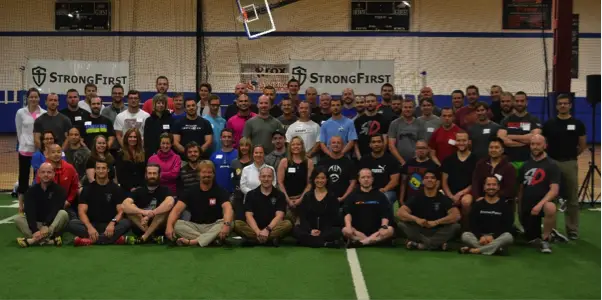
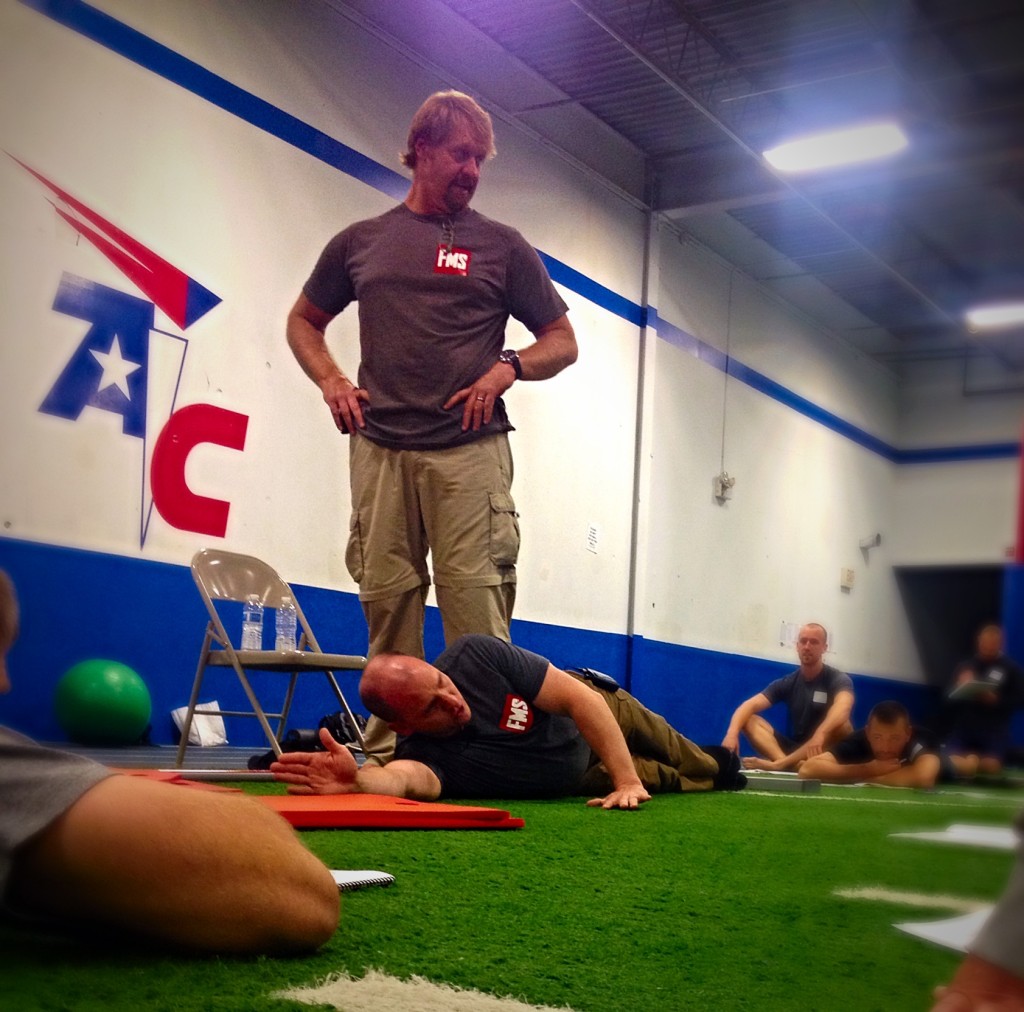
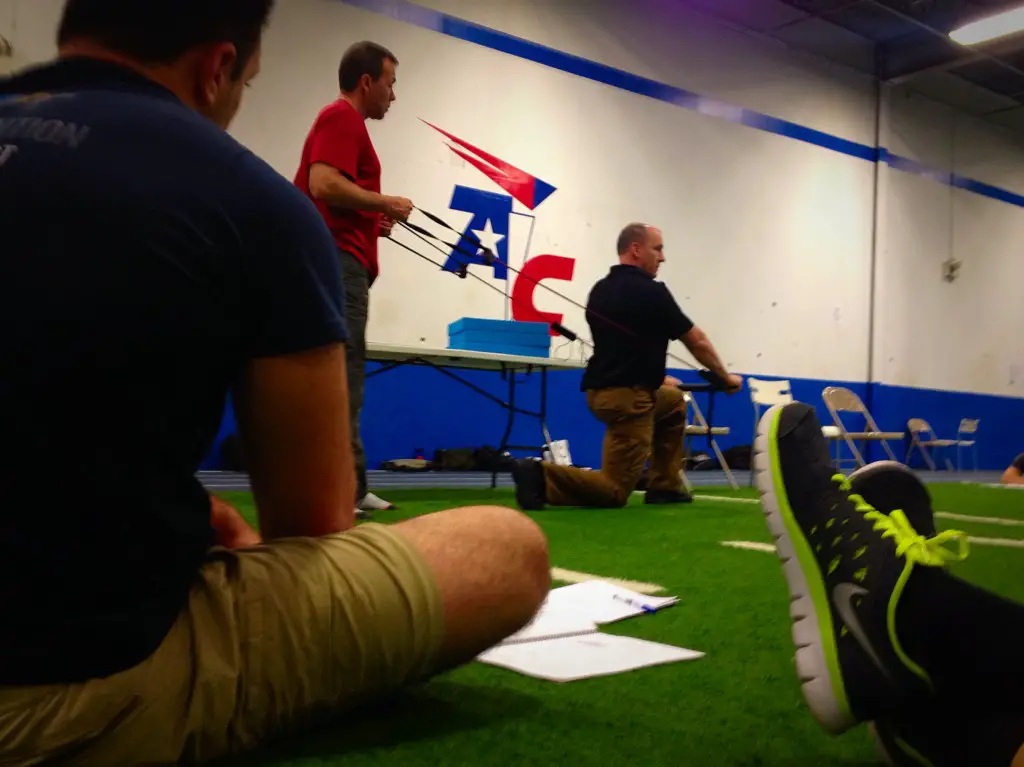
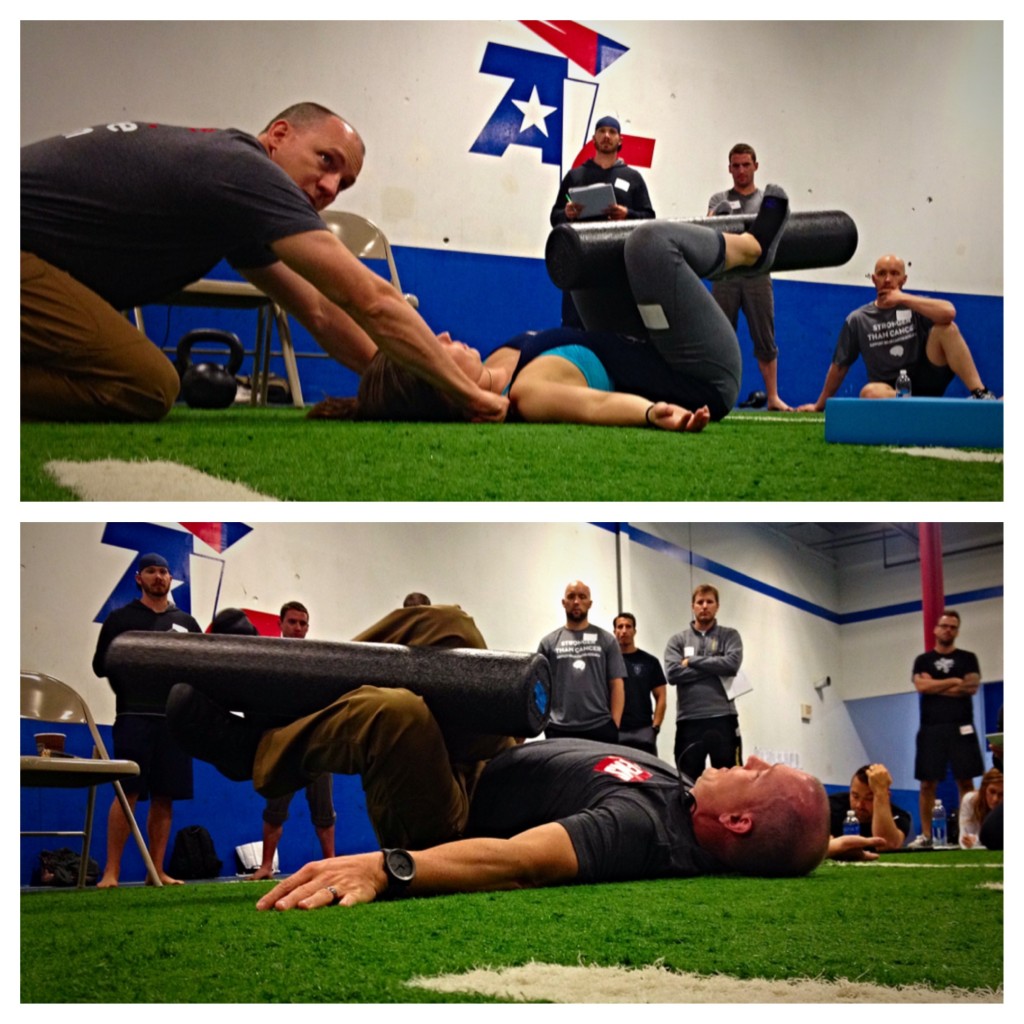
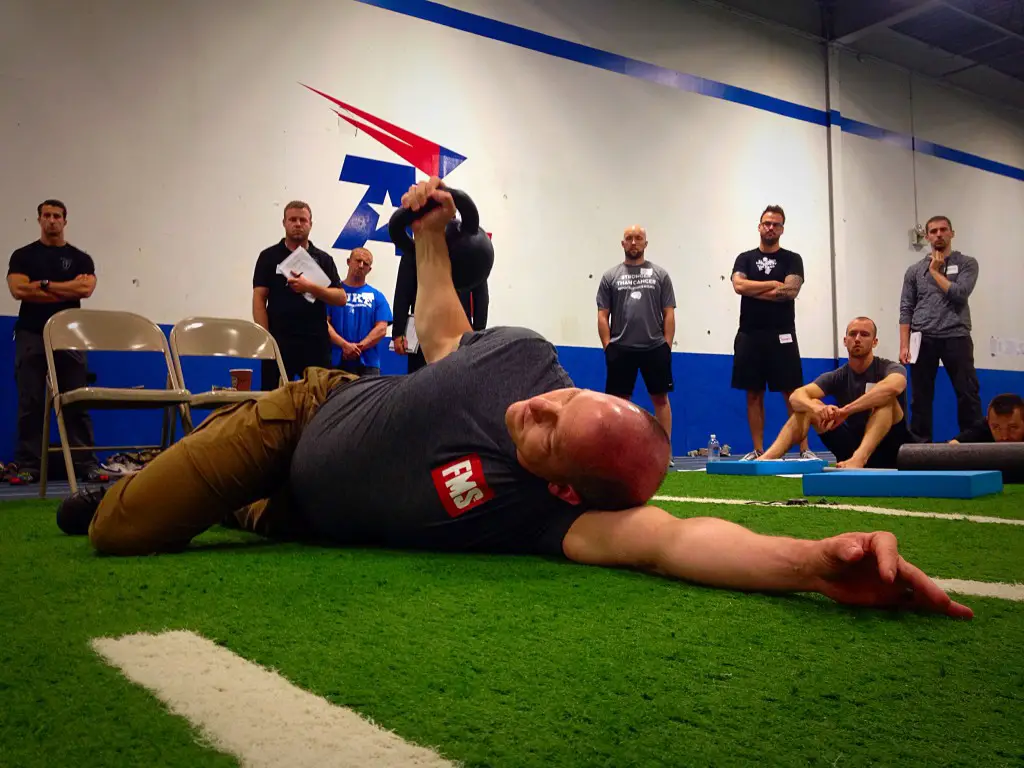
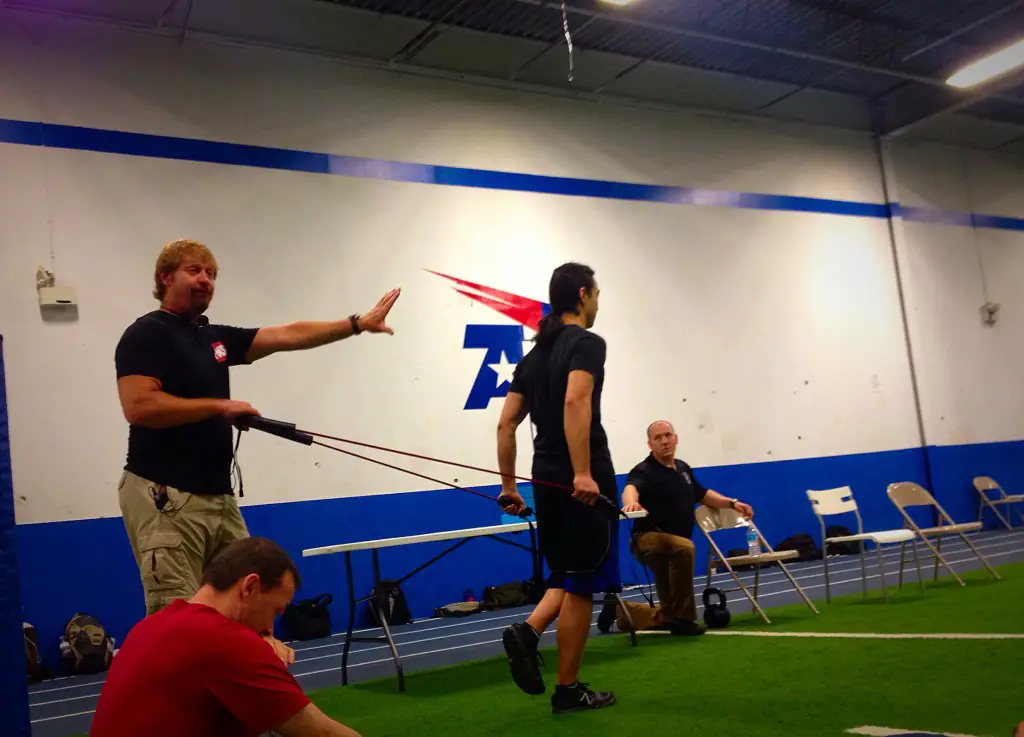



Love loaded carries for testing/training. Could you expand on #17 “Cook Drill – Overhead⇒Rack Position⇒Suitcase⇒Opposite Arm Overhead⇒Rack⇒Suitcase”?
Not following that
Gray Cook had us perform a great loaded carry drill during the course.
He first emphasized the importance of maintaining proper alignment and only pushing it to about 80% fatigue (conversational capacity). He even set up the assistants around the room to let us know when we were losing proper position. It’s not an all out, max out, exercise. It’s more about #1 & #2. And he had 1 Rule = you must change position when you either lose alignment or reach 80% work capacity.
The Cook Carry Drill:
1) Start with the KB overhead and walk until you reach the rule (lose alignment or hit 80%)
2) Then drop the KB down to rack position and walk until you reach the rule
3) Then drop the KB down to suitcase position and walk until you reach the rule
4) Then switch hands, get the KB to the overhead position, and walk until you reach the rule
5) Then drop the KB down to rack position and walk until you reach the rule
6) Then drop the KB down to suitcase position and walk until you reach the rule
7) Switch hands and repeat 1-7
He had us perform this for 12 minutes. Each position gets easier. It’s self-limiting. And it builds massive work capacity.
During the link you provided detailing the loaded carries, it speaks about abdominal bracing. However, in your post, you talked about not pre-bracing the abdominals for every rep. So what would be consider the correct way to perform a loaded carry where there aren’t distinct repetitions? Should we just concentrate on maintaining alignment and not allowing side bending to one side and/or falling into lumbar extension? Or should be be thinking about bracing the abdominals actively throughout the entire carry?
Thanks,
Andy
It depends on the person and situation. Both can be right. And there are always more than one way to accomplish a goal.
But that’s really more of a disclaimer than anything helpful…here’s my opinion.
With athletes or patients that are fairly active I rarely give the abdominal bracing cue. Like you mentioned, I have them focus on alignment, posture, breathing, and available sensory awareness (not going too high-threshold). I find most people tend to go way too fast with loaded carries and fall into lumbar extension. Slowing them down and cueing neutral spine usually gets the desired results.
However, if someone has pain or a dysfunctional movement pattern, I will sometimes cue an abdominal brace. But I always re-assess during and after the movement to see if it caused any advantageous changes.
Another important consideration is assessing regressed postures. I’m a big fan of making sure people have good core control and are able to maintain proper spine positioning in various different positions (supine, quadruped, 1/2 kneeling). I also like to check and see if people can “feel” their abdominals (not contract) as they start to become proficient in these postures. If someone can’t maintain a loaded half kneeling exercise then they probably shouldn’t be doing loaded carries.
Hope that helps!